Operators

 Indonesia: Used by armed forces and police. Production number for civilian usage is not known. [4]
Indonesia: Used by armed forces and police. Production number for civilian usage is not known. [4]  Saudi Arabia: 100 units of Perkasa bus has been sold to Saudi Arabia for commercial use. [1]
Saudi Arabia: 100 units of Perkasa bus has been sold to Saudi Arabia for commercial use. [1]
| Texmaco Perkasa | |
|---|---|
| Overview | |
| Manufacturer | PT Wahana Perkasa Auto Jaya |
| Production | 1999–2004 |
| Body and chassis | |
| Class | Truck and Bus |
| Body style | Truck, bus |
| Powertrain | |
| Engine | Steyr Motors WD612 6-cylinder 6.500 cc, power: 195 PS (type B 07 A and B 07 B), 220 PS (type B 07 BI), and 240 PS (type BiS) |
| Transmission | ZF6s-680, ZF6S-90 |
Texmaco Perkasa is a family of medium-duty commercial vehicles manufactured by Indonesian automaker PT Wahana Perkasa Auto Jaya, which is a company under the Texmaco group. Started production after the New Order in 1999 by making trucks, and in 2001 finally participated in producing variants of bus vehicles. Perkasa means "mighty" in Indonesian. These vehicles are well known in Indonesia for being the standard trucks and buses operated by the Indonesian Armed Forces. [1] Perkasa truck was first launched in late 1998, with a claim of 90% local content. TNI (Indonesian armed forces) and Polri (Indonesian national police) are the first customers, intended as military vehicles (kendaraan militer — ranmil) and tactical vehicles (kendaraan taktis — rantis). Perkasa stopped production in 2004 after the Texmaco group went bankrupt by IBRA. [2]
The Perkasa truck is claimed to have a local content of more than 90%, and was claimed as using the best technology in its class. Texmaco licensed technology from a variety of well-known truck and spare parts manufacturers in the world. As a core part, Texmaco licenses diesel engines, gears, axles, from Austrian manufacturer Steyr, they also licensed Cummins diesel engines from the United States. The diesel engine licensed by Perkasa (Texmaco Group) is a Steyr WD Series diesel engine, namely the WD 612 series and WD 602 series, the WD 612 series diesel engine is an inline 6 cylinder configuration engine with a capacity of 6956 cc, the bore × stroke size of this engine is 108 × 120 mm, the character of the engine is overstroke so that the torque is huge while the rpm is low. The engines used are: [3]
A: Steyr Diesel WD612 A, 195 Ps (220Ps-JIS) at 2,400 rpm, 650 Nm of torque at 1,300 rpm
B: Steyr Diesel WD612 B, 220 Ps (250Ps-JIS) at 2,400 rpm, torque 720 Nm at 1,300 rpm
C: Steyr Diesel WD612 C, 240 Ps (265Ps-JIS) at 2,400 rpm, torque 825 Nm at 1,300 rpm
The transmission adopts the famous German brand ZF, while the axle used is licensed from Eaton America. For the civilian version, Perkasa markets 3 truck variants, namely Perkasa T30H (tractor head), Perkasa Bromo 195 ps 4×2, and Perkasa Bromo 220 ps 6×4. Perkasa also has one truck prototype called Laskar, a tractor head that uses the cabin from DAF. [3]
The bus version is produced in 3 types, the first is front engined with code B 07 A, second rear engined with code B 07 B, B 07 Bi, the third is B 07 BiS for the ones with Turbo Intercooler engines. All variants of the Perkasa bus production use engines licensed from Steyr Motors GmbH, headquartered in Austria, type WD612 6-cylinder inline configuration of 6,500 cc with a power output of 195 PS (for types B 07 A and B 07 B) 220 PS for type B 07 BI, and 240 PS for the BiS type, and in 1997 this engine also passed the Euro 2 emission test in Europe. [1]
The engine is assembled with the chassis in Purwakarta, and combined it with the ZF transmission. This German-imported transmission is used for the Perkasa Bus series A (front) and B (rear). The transmission used ZF6s-680 which has a short-ratio character, and for an engine that uses a Turbo Intercooler, Perkasa paired it with the ZF6S-90 which has a longer gear ratio. [1]
The chassis itself consists of two variants with a length of 11,325 mm for the front engine and 11,675 mm for the rear engine variant. The wheelbase is 5,800 mm (A, front engine) and 6,000 mm (B), almost the same as the wheelbase of the Hino RG, equipped with the American-manufactured Eaton front-rear axle. In the specifications, the front axle can withstand loads of 7,725 kg and for the rear can withstand up to 10.5 tons. The vehicle has full air brake system S-Cam, where the drum has a diameter of 419 mm x 160 mm. [1]


The Mazda Bongo, also known as Mazda E-Series and the Ford Econovan, is a cabover van and pickup truck manufactured by the Japanese automobile manufacturer Mazda since 1966. The Bongo name was also used for the Bongo Friendee, which is not a cabover design.
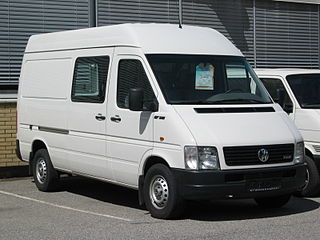
The Volkswagen LT is the largest light commercial panel van produced by Volkswagen from 1975 to 2006, before being replaced by the Crafter. Two generations were produced.
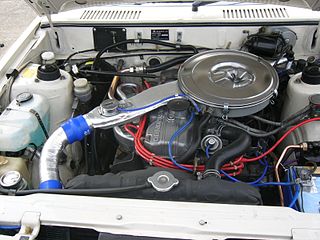
The Mitsubishi Astron or 4G5/4D5 engine, is a series of straight-four internal combustion engines first built by Mitsubishi Motors in 1972. Engine displacement ranged from 1.8 to 2.6 litres, making it one of the largest four-cylinder engines of its time.
The Navistar VT engine family is a line of diesel engines that was produced by International Truck and Engine from 2003 to 2016. Developed as the replacement for the T444E V8, the VT V6 and V8 diesels were the smallest diesel engines used in Navistar vehicles, slotted below the DT inline-6 engine family. Sharing many applications with the DT466 inline-6, the VT engines were used in medium-duty trucks and school bus chassis, competing against the Cummins B-series and the Mercedes-Benz MBE900 diesel engines. In 2007, both the VT and DT engines were rebranded under the MaxxForce brand name, with model designations related to their displacement.
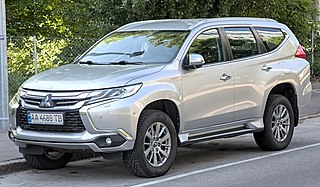
The Mitsubishi Pajero Sport is a mid-size SUV produced by the Japanese manufacturer Mitsubishi Motors using the Pajero nameplate since 1996 that has spanned over three generations and based on the Triton pickup truck. Mitsubishi has formerly used the Mitsubishi Challenger name in Japan and some international markets, but since the third generation, the Pajero Sport/Montero Sport/Shogun Sport was the name used instead.

The Ford Super Duty is a series of heavy-duty pickup trucks produced by the Ford Motor Company since the 1999 model year. Slotted above the consumer-oriented Ford F-150, the Super Duty trucks are an expansion of the Ford F-Series range, from F-250 to the F-600. The F-250 through F-450 are offered as pickup trucks, while the F-350 through F-600 are offered as chassis cabs.
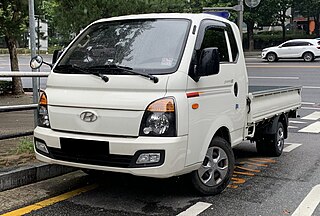
The Hyundai Porter, also known as the Hyundai H-100, is a cabover Pickup truck produced by the South Korean manufacturer Hyundai since 1977.

The Volkswagen Constellation is the flagship truck produced by the Brazilian manufacturer Volkswagen Truck & Bus since 2005. The line covering the 13-57 tonne gross combination mass (GCM) segment. It is produced at Resende in Brazil, and is primarily for the South American market.

The Toyota Dyna is a light to medium-duty cab over truck for commercial use. In the Japanese market, the Dyna is sold alongside its twin called the Toyoace. The Toyoace was a renaming of the Toyopet SKB Truck as a result of a 1956 public competition with 200,000 entries. "Dyna" is short for dynamic.
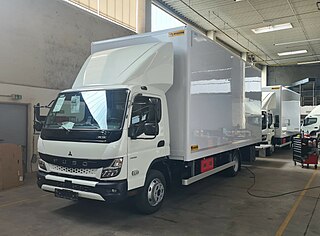
The Mitsubishi Fuso Canter is a line of light-duty commercial vehicles manufactured by Mitsubishi Fuso Truck and Bus Corporation, part of Daimler Truck, subsidiary of Mercedes-Benz Group. The Canter is manufactured since 1963, now in its eighth generation. The Canter is named after the English word describing the gait of a horse, emphasising the 'thoroughbred' nature of Mitsubishi trucks.

The Isuzu Elf is a medium duty truck produced by Isuzu since 1959. Outside Japan it is known as N series and Q Series. The range was originally mainly available in Japan and other Asian countries. Australia was another important market for the Elf and N series – to the extent that it was manufactured there from the 1970s using many local components. Since the early 1980s, it has also been sold and built in the United States, and also as the Isuzu N-Series. Only North America receives the wide-cab version.

The Daihatsu Rugger is an off-road vehicle built by Daihatsu between 1984 and 2002. The Rugger was also called the Rocky in most export markets, and Fourtrak in the United Kingdom. It has also received a series of different names elsewhere, which is why it is often referred to by its model designation to distinguish it from its various siblings. In Japan and the US, the Rocky name refers to the smaller F300 series of Daihatsu vehicles.

The Suzuki Carry is a kei truck produced by the Japanese automaker Suzuki. The microvan version was originally called the Carry van until 1982 when the passenger van versions were renamed as the Suzuki Every. In Japan, the Carry and Every are kei cars but the Suzuki Every Plus, the bigger version of Every, had a longer bonnet for safety purposes and a larger 1.3-liter 86-hp (63 kW) four-cylinder engine. They have been sold under myriad different names in several countries, including those with Chevrolet and Ford badges.

The Chevrolet Van or Chevy Van is a range of vans that was manufactured by General Motors from the 1964 to 1996 model years. Introduced as the successor for the rear-engine Corvair Corvan/Greenbrier, the model line also replaced the panel van configuration of the Chevrolet Suburban. The vehicle was sold both in passenger van and cargo van configurations as well as a cutaway van chassis that served as the basis for a variety of custom applications.

The "New Generation“ is a series of trucks by Daimler-Benz built from 1973 to 1988. It was then replaced by the Mercedes-Benz SK series. With the "New Generation", Daimler-Benz expanded its market position in the medium and heavy truck segments. Its cab was also used by Mercedes-Benz of North America, who confusingly offered it with inline-six or -five engines as the LP series beginning in 1985.

The Ikarus 55 is a high-floor coach designated for long-distance as well as interurban traffic, and the first rear-engine Ikarus bus. It was made from 1952 – 1973, alongside the technically related Ikarus 66, by the Hungarian bus maker Ikarus. In total, 8,350 Ikarus 55 and 66 were delivered to East-Germany.
The Toyota FA and BA were heavy duty trucks introduced in February 1954. They were facelifted versions of the earlier BX/FX trucks, retaining those trucks Type B and Type F six-cylinder petrol engines. The first letter in the model name indicates the engine family fitted; in 1957 the Type D diesel engine was introduced in a model known as the DA. The second letter indicated the size of the truck, with shorter medium duty versions being coded BC/FC/DC. A second letter "B" was used on bus versions of this chassis. A second generation FA/DA was introduced in 1964 and was built in Japan until 1980, when Hino replaced Toyota's heavier truck lines entirely. The DA, however, was also built in numerous other countries and manufacture continued into the first decade of the 21st century.

The SAMIL 20 is a 2-ton cargo vehicle produced in South Africa in the mid-1980s and was used as the primary light cargo carrier of the South African National Defence Force. The vehicle design is based on the German Mercedes Unimog chassis and Mark I of this vehicle was based on the Magirus Deutz 130M7FAL 4x4 truck. In Mark II, the engine was replaced with an upgraded South African built water cooled diesel engine. The vehicle is still in use with the SANDF.

The Pindad APS-1 or APS-1 is an armored vehicle made by Pindad. The vehicle is based on the APR-1V with improved capabilities by using 6×4 wheel drive.
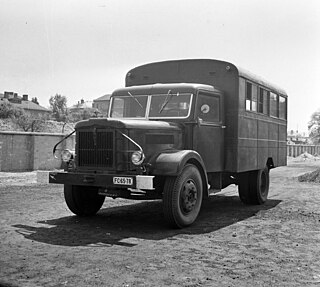
The Csepel D-350 is a lorry made by Hungarian manufacturer Csepel Autógyár from 1950 until 1958. It was the first series production Csepel vehicle, and a copy of the Austrian Steyr 380 lorry, built under licence.